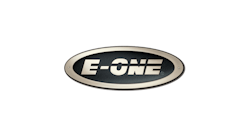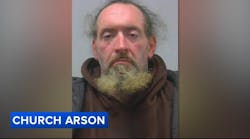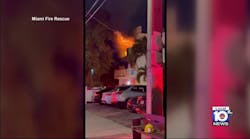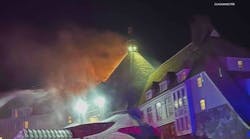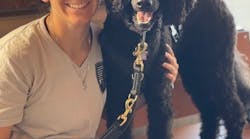What Boston is not notable for is its ample open space or wildlands and the fire problems associated therewith. Within its city limits, Boston contains an estimated 4,000 acres of wildlands in the form of parks, woods, grass and brush lands which also includes the harbor islands. Many wood framed homes and other structures are located in close proximity to these wildlands creating true structural wildland interzones within this highly urbanized city.
Historically, busy fire activity in these wildland and interzone areas has occurred in the spring when the standing and downed dead vegetation has been freeze-dried and cured out from the previous winter. If the summer has been very hot and dry, additional fire activity occurs. This may also transition into a dry and active fall fire season that usually terminates in early November. It is all weather dependant.
Most of these fires are kept to 1-acre or less in size. However, some fires can and do grow rapidly in size and complexity becoming a direct threat to firefighter and civilian life safety. Structures in close proximity to these fires are also threatened.
An initial response of apparatus to the report of a wildland fire in Boston is usually 1 or 2 engine companies and a District Fire Chief. The assignment can be upgraded by the IC to include additional engines, a full first alarm assignment of 3 engines, 2 ladder companies with a special request for a Brush Fire Unit(s) (BFU) or multiple alarms as conditions dictate.
How The Fires Were Fought
Past accounts show that Boston Firefighters fought wildland and SWI fires the best that they could with the structural firefighting equipment that they had. This included large fire apparatus that were not designed for off-road use, heavy-weight structural fire hose, shovels , brooms, back pack pumps, structural turn-outs and rubber boots. In the late 1920's/early 1930's, Boston Fire purchased 2 specially equipped motorcycle brush fire patrol units for use in the heavily wooded areas of the city's West Roxbury and Hyde Park sections. Reportedly, these motorcycle units were not very satisfactory and suddenly were put out of service and disappeared. it was recently rumored that a collector of old motorcycles, who lives in Germany, found and restored one of these Boston Fire Department motorcycle brush fire patrol units and added it to his collection.
During past busier spring fire seasons, many Boston residents knew that large stubborn wildland fires were burning because they could see large columns of smoke coming from wooded areas. The smell of burning vegetation permeated many neighborhoods for days and weeks at a time. Until the early 1970's, the burning of fall leaves by residents had been a permitted annual event. It was something akin to a rite of fall.
This unsafe practice was the cause of many large wildland and SWI fires. More than a few structure fires were caused by piles of burning leaves left unattended. Large sections of Boston were oftentimes covered in a pall of aeromatic smoke caused by the piles of smoldering leaves and burning wildland fires. Numerous Boston Fire Companies were kept busy fighting the fires for hours or days on end. At times the city's fire protection became dangerously thin and mutual-aid would be brought in to cover vacant fire stations. Boston Firefighters had a difficult time controlling and suppressing these large wildland fires while using structural firefighting equipment. Something had to change.
It wasn't until the spring of 1984 that the traditional way of fighting wildland and SWI fires in Boston would finally yield to progress. The impetus for this needed change in equipment came about, in part, after a large fast moving wildland fire chased firefighters out of the woods, threatened a neighborhood of wooden homes and required the striking of 3 alarms with extra engine companies special called to quell the fire.
In the' aftermath of this fire light-weight forestry hose was borrowed from the Town of Duxbury, located 30 miles to the south of Boston, to field test. It was placed on Engine Company 48, which is located in one of the more active wildland fire areas in Boston. This light-weight forestry hose was a new experience for Boston Firefighters. It was a huge success and Boston Fire purchased its first lengths of forestry hose in 1984.
Next came the need for a more appropriate piece of mobile fire apparatus. Big pumpers traveling off-road into the woods, becoming bogged down in mud, tree limbs scrapping off the gold-leaf paint from the trucks, breaking off lights and mirrors was not the way to fight wildland fires. So, plans were drawn up to retro-fit a recently decommissioned midi-pumper and to develop it into Boston Fire's first true Brush Fire Unit.
The midi-pumper was outfitted with a stronger front bumper, a brush guard, .a. small independent gasoline fire pump on the rear step for pump-and-roll operations, a booster tank holding 450 gallons of water, 1,000 feet of 1 1/8" forestry hose and 1,000 feet of 110 hose, some 3" hose for use as a hydrant line and various tools and equipment designed for Brush Fire Unit #1 was assigned to Engine Company 48 during the fall of 1984. The BFU #l was so successful in its use that a second identical unit was established one year later and assigned to Engine Company 55 as BFU #2.
It has been over a dozen years since Boston's Brush Fire Units became operational and changed the way we fight wildland and SWI fires in certain sections of this city. These BFU's had been worked often and hard and became mechanically tired. The time had come for yet another progressive move forward for the Boston Fire Department.
New Brush Units Purchased
Once again, plans and specifications were formulated to fulfill the needs of the Boston Fire Department relative to wildland and SWI fire operations. Two new state-of-the-art Brush Fire Units would be purchased. These two BFU's were not going to be retro-fitted pumpers! They would be new trucks designed for firefighter safety, efficiency, effectiveness and economy in mind. The BFU's that we wanted would be wildland/urban interface (SWI) vehicles designed with a wide range of operational capabilities.
In mid-November, 1997, Boston Fire took delivery of "twins." Twin Brush FireUnits, that is. Coincidentally, it took about 9 months from their formative stages to the delivery time.
The new BFU's were assigned the radio ID designations of Brush Unit 48 and Brush Unit 55 that coincides with their assigned Engine Company 48 and Engine Company 55, respectively. The new BFU's are equipped as follows:
- 1998 E-One/International 4900 Series chasis/4-door/5-person crew cab
- GVW-R 31,000 lbs.
- 210 HP diesel International motor w/Allison 4-speed auto transmission
- Volkswagen 4 cyl. 57 hp in-line water cooled pump rated at 650 gpm, pump-and-roll operation
- 500 gallon water tank w/20, gallon reservoir for class A-foam concentrate HyPro Class A-Foam System
- Dual hose reels, hose beds, compartments for tools/equipment
- Bumper mounted turret by Akron Brass, 300 gpm, in-cab remote controlled
- Detroit "No-Spin" rear end
- 12,000 lb. electric winch
- Perimeter lighting
- Brush guard in front
- Length of BFU is 25' 1" for tight turning radius
- Light-weight hose of various diameters, hand tools for wildland firefighter
- 6 sets each of wildland turnouts complete with helmets, gloves and goggles are being considered as additional equipment
In service training for members of Engine Companies 48 and 55 began soon after the arrival of the new BFU's with a strong emphasis on the use of Class A-Foam for wildland and SWI fire suppression. An SOP for wildland and SWI firefighting in Boston has been completed and is awaiting final approval.
As the Boston Fire Department moves ahead into the 21st Century, its firefighters are better equipped, trained and more capable of controlling and suppressing wildland and Structural Wildland Interzone fires than ever before.




